Koshari (also spelled koshary) is Egypt’s national dish, a staple food in Egyptian homes and street stalls that just happens to be completely Vegan! This unique dish combines rice, lentils, pasta, chickpeas, and a zesty tomato sauce topped with crispy fried onions, into a symphony of tastes and textures that will transport you straight to the bustling streets of Cairo!
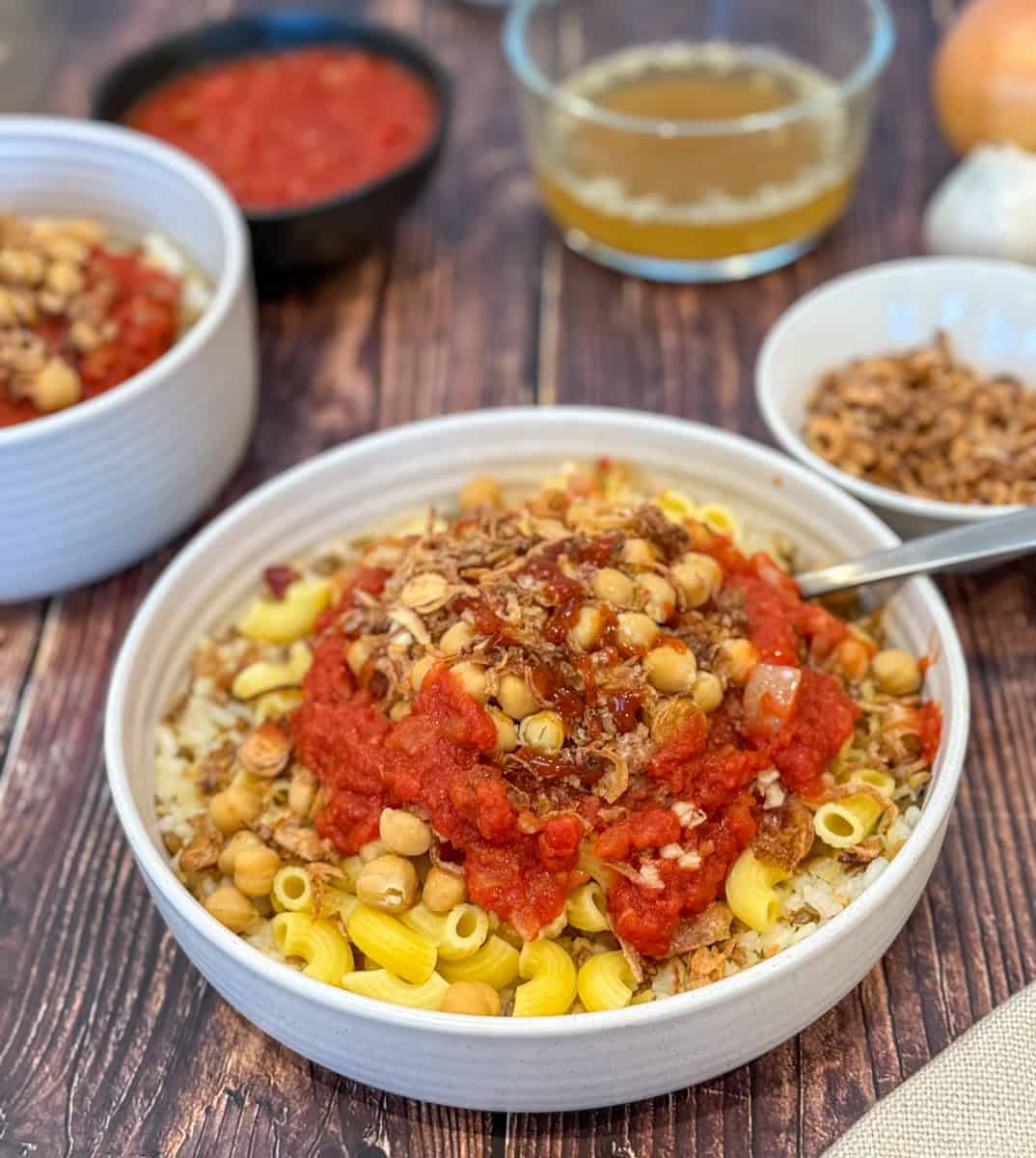
I lived in Egypt for many years, and actually went from Vegetarian to Vegan when I was living in Cairo. I was surprised at just how vegan-friendly the local cuisine was. Egyptian food offers an incredible variety of plant-based dishes that are both satisfying and delicious. For example, ‘Ful Madames’, which is a traditional Egyptian breakfast dish made from mashed fava beans and spices, and is absolutely yum! These beans are often served with ‘Taamaya’, the Egyptian version of falafel, made from ground fava beans instead of chickpeas. These are just a few of the many vegan Egyptian dishes that I hope I will be able to recreate and post the recipes!
But on to ‘Koshari’, the heart of Egyptian comfort food, made with layers of rice, lentils, pasta, chickpeas, and fried onions that come together with the tomato ‘Salsa’ sauce to create a unique dish like no other. Making it from scratch is also incredibly fun! So next time you’re craving something warm, filling, and full of flavour, whip up a batch of Koshari and enjoy the true taste of Egypt right in your own kitchen!
Ingredients
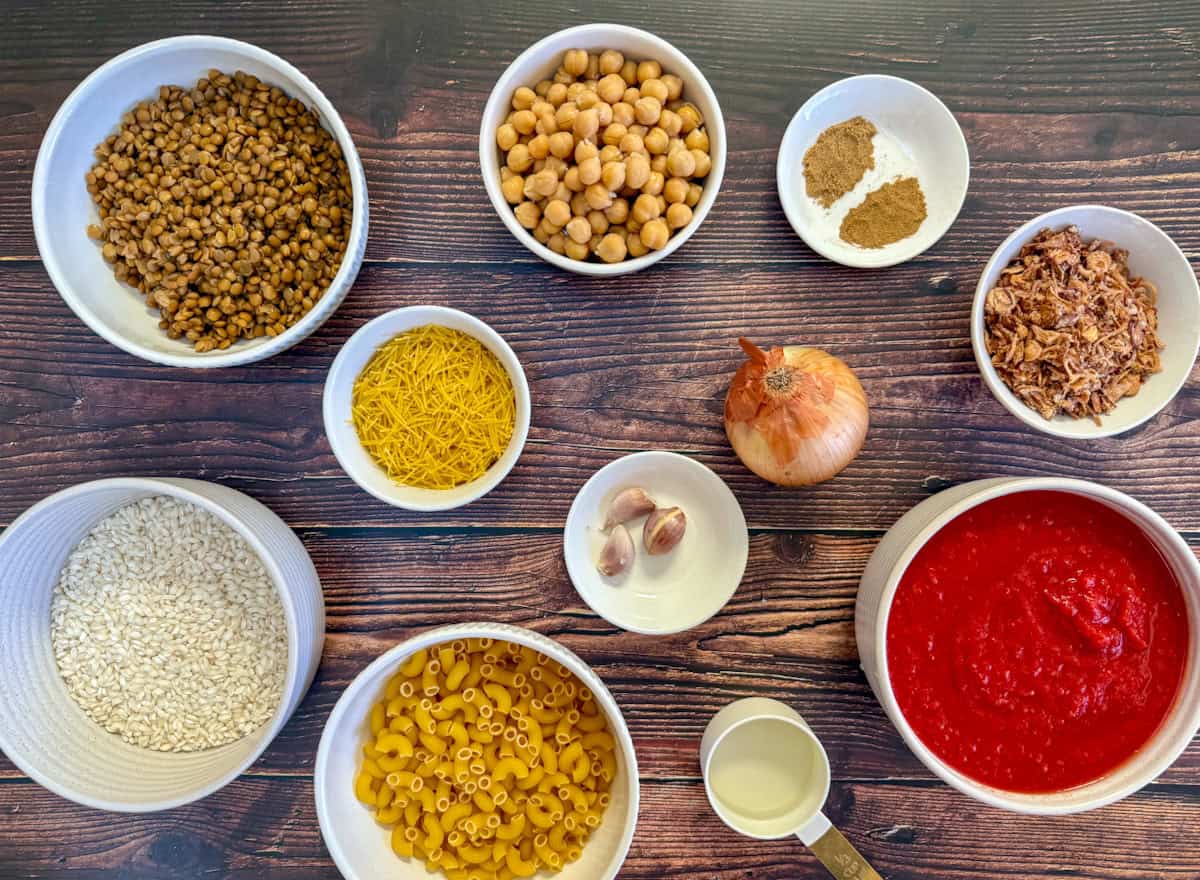
- Rice-Short-grain or medium-grain rice is preferred for Koshari because it has a slightly sticky texture that helps the dish come together. Long-grain rice can also be used. Tip: Rinse the rice thoroughly before cooking to remove excess starch, which can make the rice clump together.
- Vermicelli- Egyptian rice is often cooked with vermicelli pasta (‘Roz bel She’reya’). For this rice, thin, short vermicelli pasta is used. It’s important to use the right type of vermicelli, which is delicate and thin. You can find this pasta in most Middle Eastern grocery stores. The vermicelli is then lightly fried in oil to ‘toast’ it slightly before adding the rice. The toasting process adds a nutty flavour, which is characteristic of Egyptian vermicelli rice (see below).
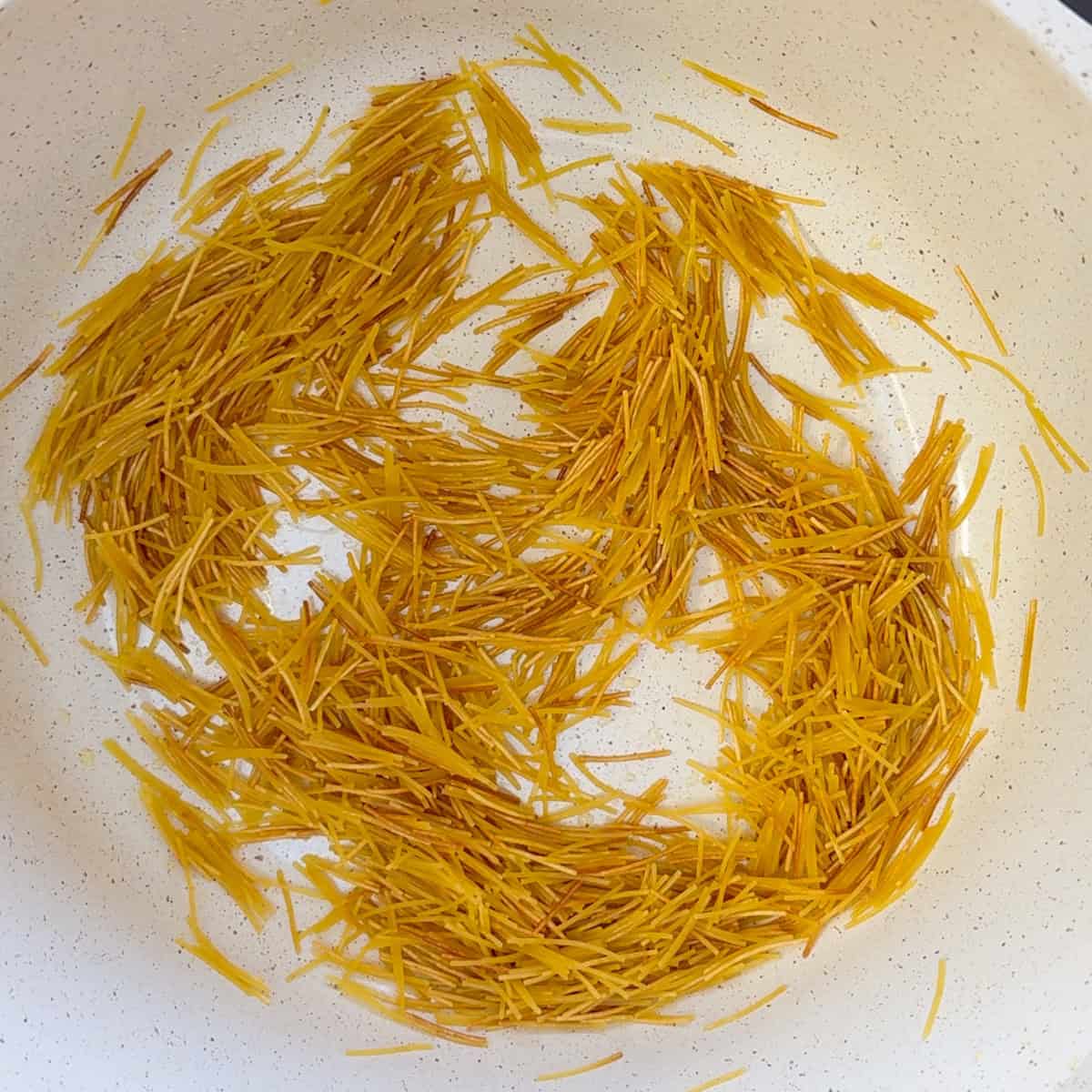
- Brown lentils-Brown lentils are commonly used in Koshari. They hold their shape well when cooked and offer a hearty texture. I struggled to find dried brown lentils where I live so I used store-bought canned brown lentils. However, this meant I could not cook the brown lentils and rice together which you may see in other recipes.
- Pasta- Small pasta like elbow macaroni is the classic choice, but other small pasta shapes (like ditalini or macarnoni) can work as well.
- Chickpeas- For ease I use canned chickpeas in this recipe as there are quite a few ingredients to prepare! But you can cook dried chickpeas yourself if you prefer.
- Crispy fried onions- The crispy fried onions are what truly elevate Koshari. Egyptians call this the layer on koshari the ‘Ward’ meaning flowers! Traditionally the ‘ward’ are thinly sliced onions that are battered and deep-fried until golden and crispy. However, many Egyptians use store-bought crispy fried onions which I also used in this recipe as I don’t feel experienced enough yet to cook them from scratch!
- White vinegar– Vinegar plays a vital role in Koshari, adding a tangy and slightly acidic flavour to the tomato ‘salsa’ and ‘dakka’ sauce (see below). Distilled white vinegar or white wine vinegar can be used. Other vinegar such as apple cider vinegar would change the taste, hence not recommended.
- ‘Dakka’ sauce– There’s one more element that takes Koshari from delicious to unforgettable—the ‘Dakka’ sauce. The Dakka sauce is a tangy, spicy garlic and vinegar dressing that’s poured over the dish just before serving, adding an extra burst of flavour that ties everything together. The sauce is made by combining freshly minced garlic, white vinegar, water and cumin. The sauce is traditionally poured generously over the dish, which adds a spicy kick to the Koshari.
- ‘Shaata’ Sauce– ‘Shaata’ sauce (roughly translating to ‘chilli sauce’) is another common Koshari garnish. In Koshari restaurants in Egypt you will often see harissa sauce or other chilli sauce bottles sat on the tables next to the ‘dakka’. This time I used store-bought ‘Sriracha’ sauce for extra heat!
Koshari Layers
At its core, Koshari is a layered dish, and the order in which you arrange each component plays a huge role in the final experience. The proper layering helps the rice absorb the flavours, ensures the crispy fried onions stay crispy, and gives the tangy sauces the chance to shine. I confirmed with my Egyptian husband that I was layering the dish in the correct order to make sure I got it right!
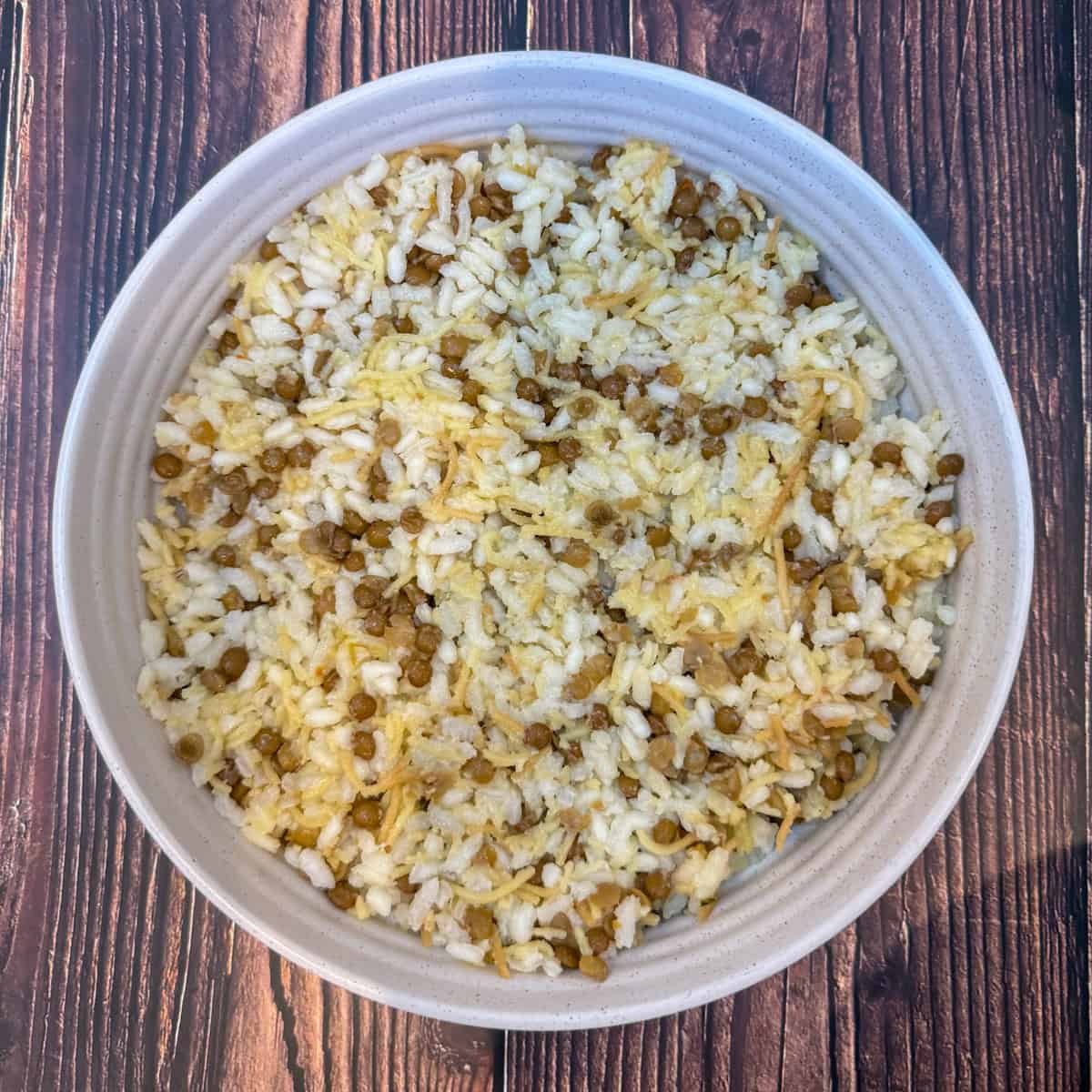
- Step 1: The first layer is vermicelli rice and lentils. Some restaurants serve plain rice followed by a layer of brown lentils.
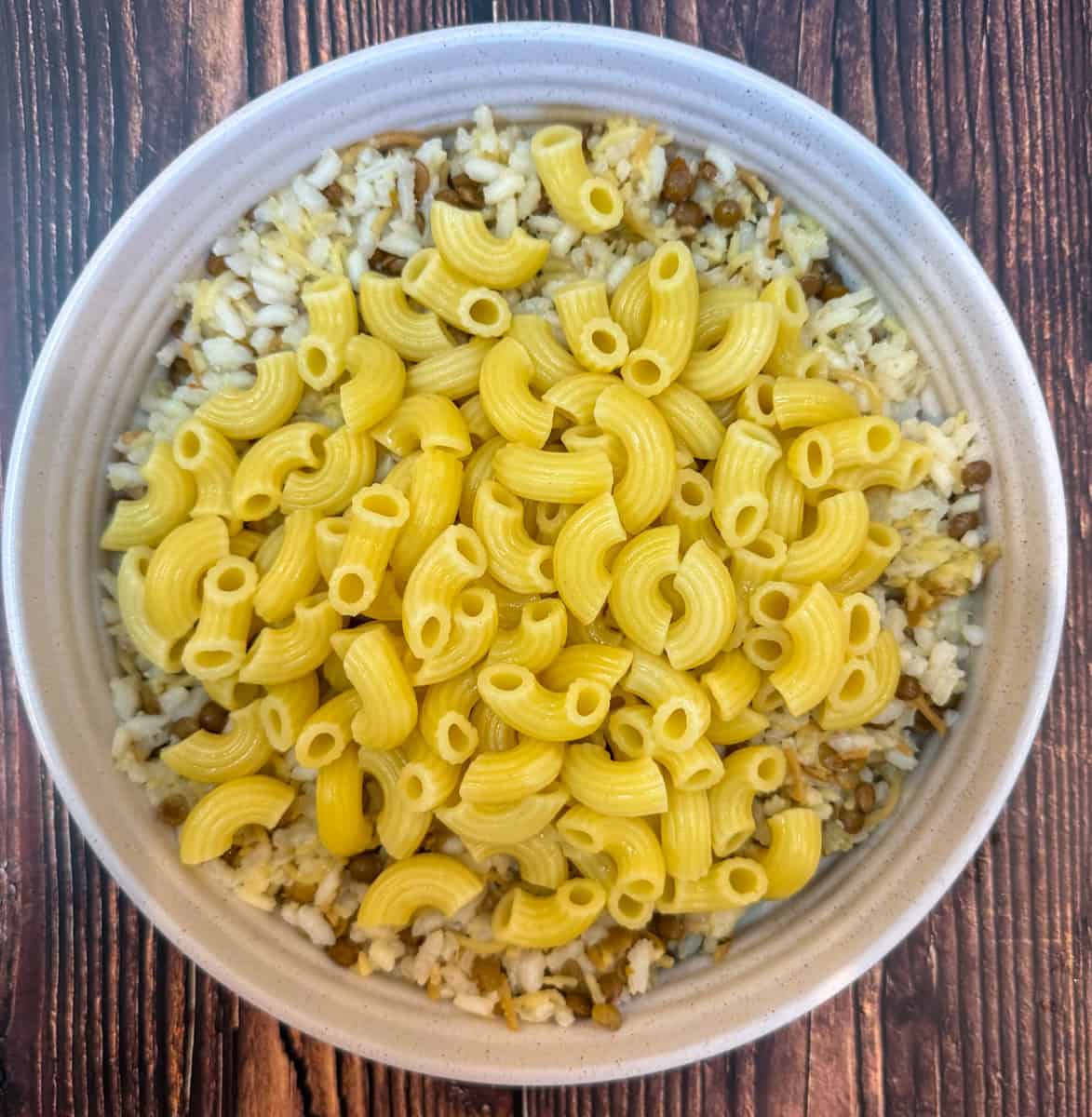
- Step 2: The next layer is the cooked elbow pasta.
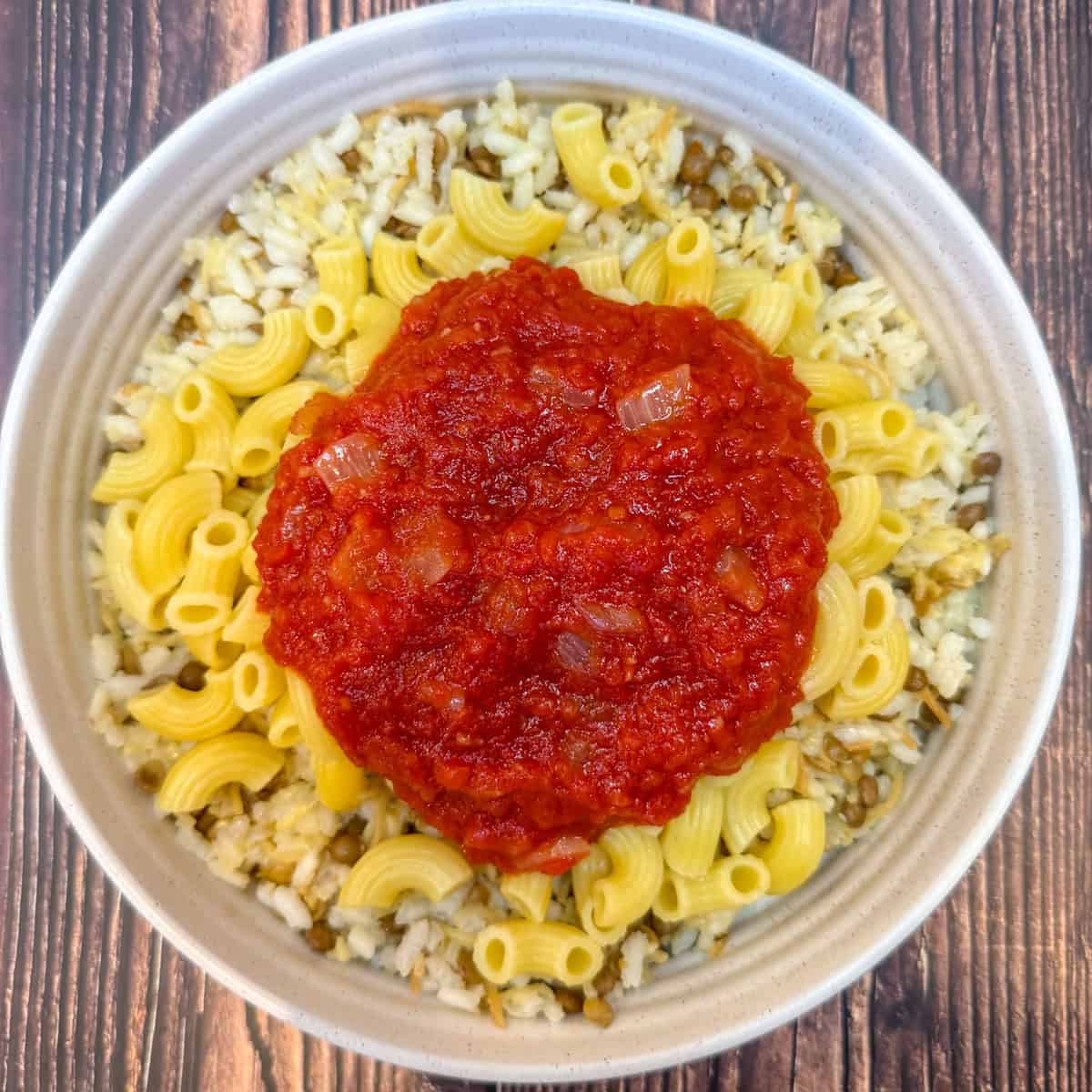
- Step 3: The next layer is the tomato ‘Salsa’ sauce.
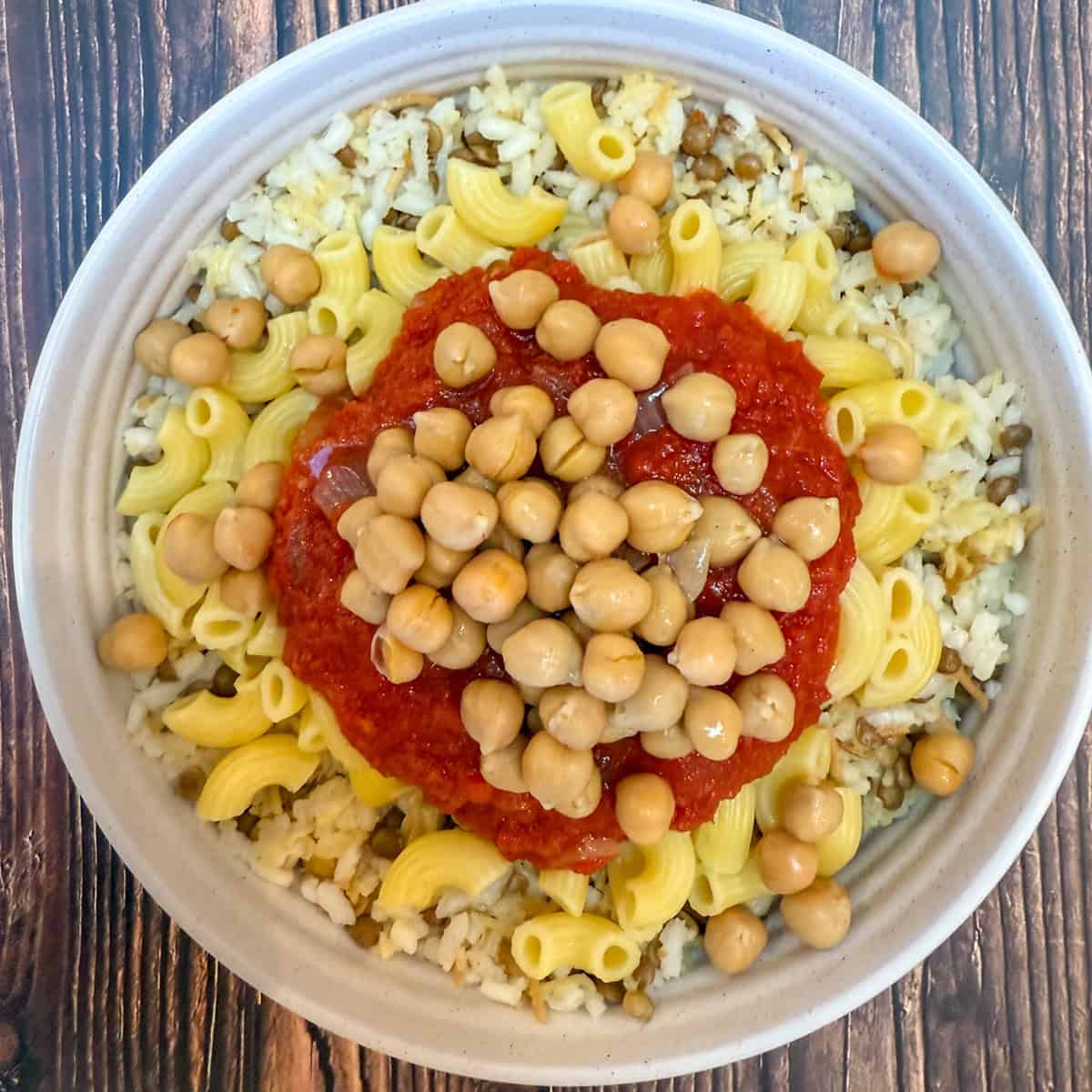
- Step 4: The next layer is the chickpeas, lightly spiced with cumin and lemon/ lime juice.
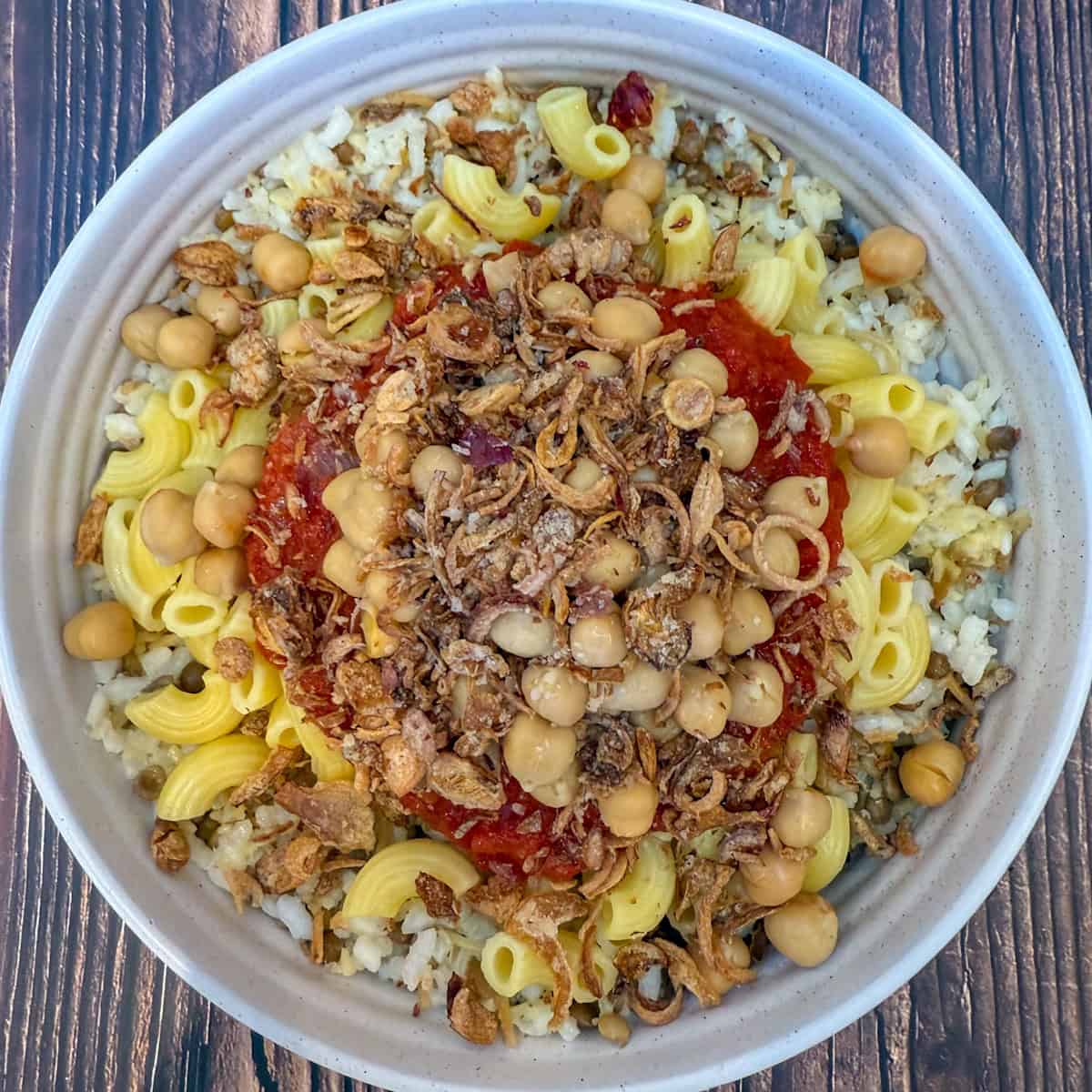
- Step 5: The last layer is the crispy onions- the ‘Ward’!
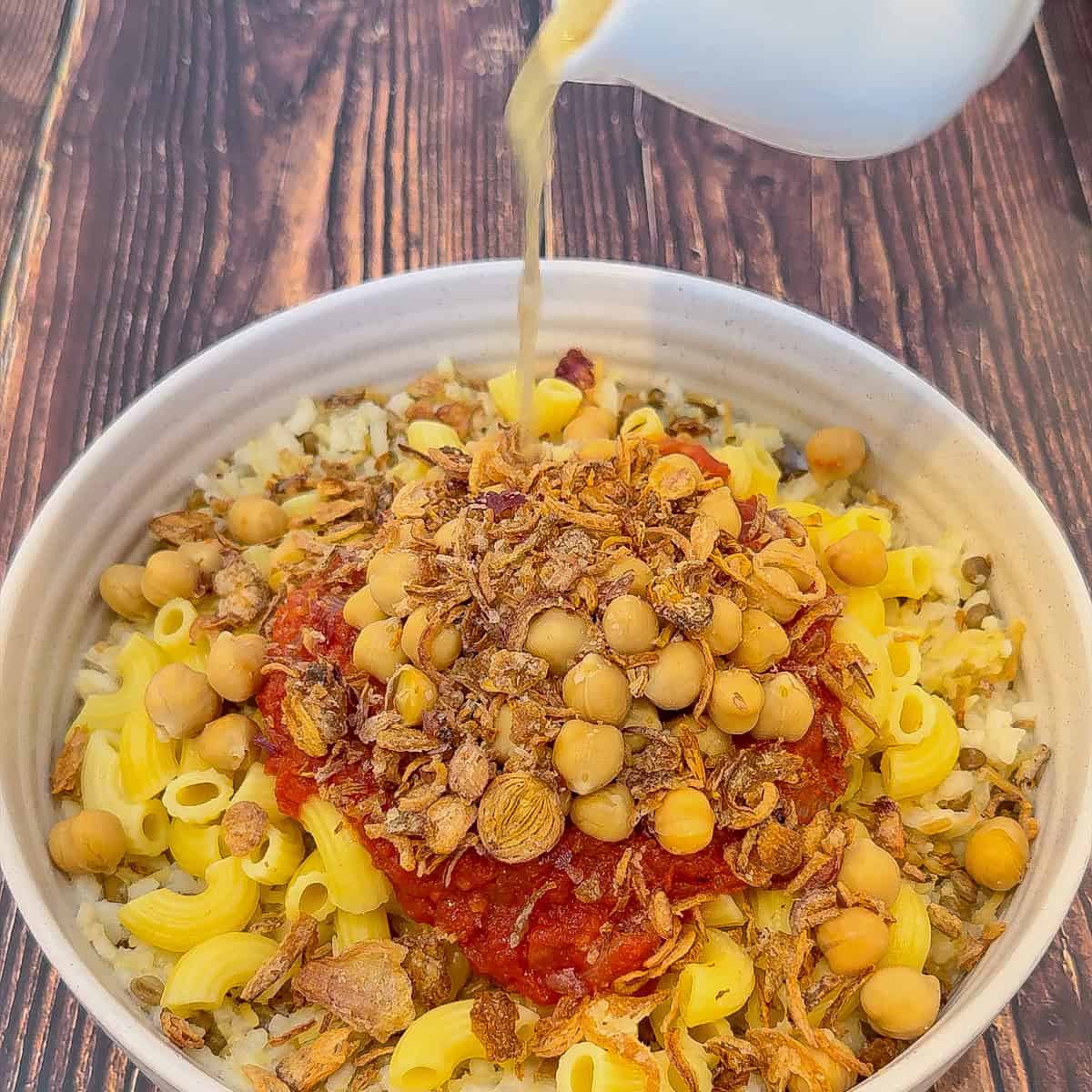
- Step 6: Finally pour the ‘dakka’ sauce over your koshari, and then ‘shaata’ sauce if you want extra spice!
I hope you enjoy making this dish as much as I have! Happy cooking! 🌱🌱
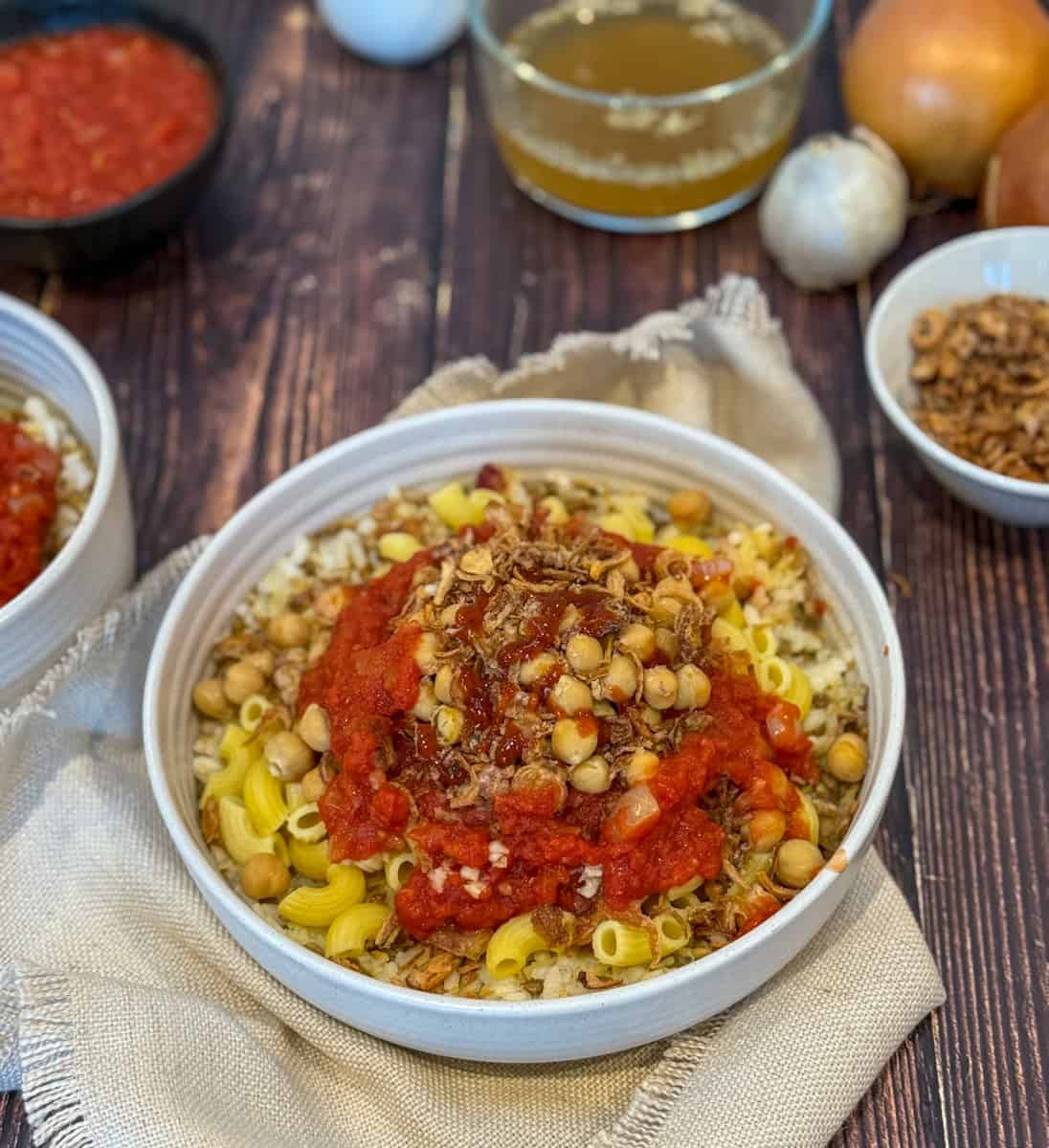
Related
Looking for other recipes like this? Try these:
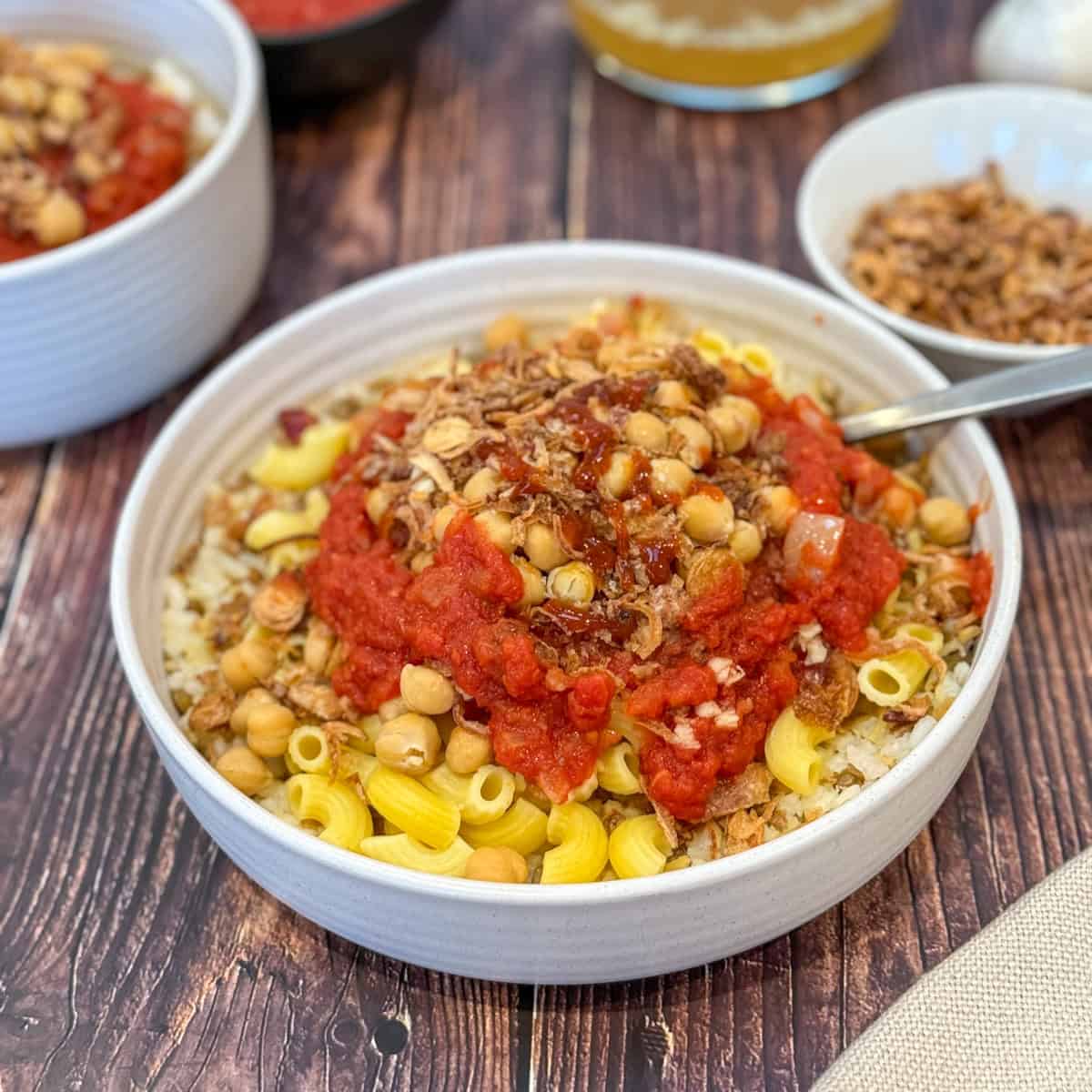
Ingredients
For koshari base
- 1 tablespoon Vegetable oil or olive oil
- ⅓ cup vermicelli pasta
- 1 cup rice (short-grain or medium-grain) Rinse in cold water before cooking
- 1 ¾ cup water
- 1 teaspoon salt
- 1 can cooked brown lentils Or ½ cup dried brown lentils (cooked)
- ½ pack elbow macaroni or any small pasta, cooked and drained
- 1 can cooked chickpeas
- 1 teaspoon cumin To flavour chickpeas
- 1 teaspoon lemon juice To flavour chickpeas
For tomato 'salsa' sauce
- 2 tablespoon vegetable oil
- 1 medium onion, chopped
- 3-4 cloves of garlic, minced
- 1 large or 2 small cans of passata Or diced tomatoes
- 1 teaspoon ground cumin
- 1 teaspoon ground coriander
- 1 teaspoon salt
- 2 tablespoon white vinegar
For the 'Dakka' sauce
- 4-5 garlic cloves (finely minced or crushed)
- 2 tablespoons white vinegar
- ½ teaspoon ground cumin
- ½ teaspoon ground coriander
- ½ teaspoon salt
- ¼ cup water More or less depending on desired consistency
To garnish
- Crispy fried onions
- Sriracha or harissa hot sauce
Instructions
Make the vermicelli rice
- Heat the oil in a medium-sized saucepan over medium heat. Add the vermicelli to the pan to lightly toast them. Stir constantly to prevent burning, until the vermicelli turns golden brown and develops a nutty aroma (about 2-3 minutes).
- Once the vermicelli is golden brown, add the rinsed rice to the pot and stir to combine it with the toasted vermicelli. Continue to cook for another 1-2 minutes to lightly toast the rice.
- Add water and salt to pot. Cover and bring to boil, then reduce heat and cook on low heat for about 15-20 minutes or until the rice is tender and fully cooked.
- When rice is nearly ready, stir in cooked brown lentils. Cover and set aside.
Cook the Pasta:
- If you haven't already, boil the pasta in a separate pot of salted water according to the package instructions. Drain the pasta and set it aside.
Make the tomato sauce:
- In a large pot, heat 2 tablespoons of oil over medium heat. Add the chopped onions and minced garlic and sauté until onions are golden brown and becoming soft.
- Add the passata or diced tomatoes, cumin, coriander, salt, and white vinegar to the pot. Stir everything together and let the sauce simmer on low heat for 10-15 minutes. Set aside.
Prepare the chickpeas
- Wash and drain the chickpeas. Heat in a small pot with a small amount of water, cumin and lemon juice. Set aside.
Make the 'Dakka' sauce
- Add the minced garlic, white vinegar, cumin, ground coriander and salt to a small bowl or glass. Mix well with a fork or spoon. Set aside.
Assemble the koshari
- In bowls start assembling the koshari (see photos above). Start with the vermicelli rice and brown lentils, followed by cooked pasta, tomato sauce, chickpeas, and finish with crispy onions.
- Pour the 'dakka' sauce over koshari, start with small amounts and add according to taste. Add sriracha or harissa sauce. Enjoy!


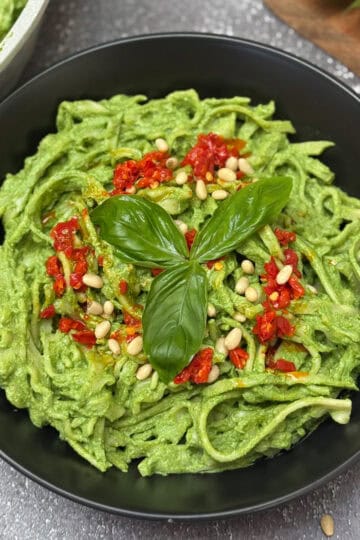
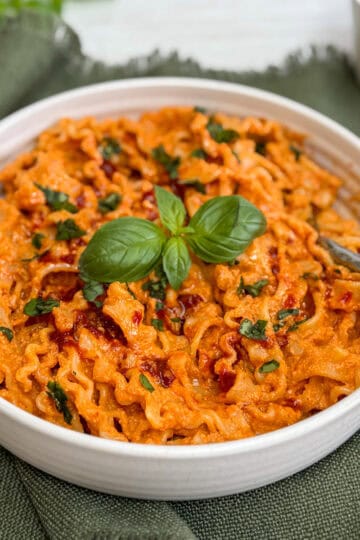

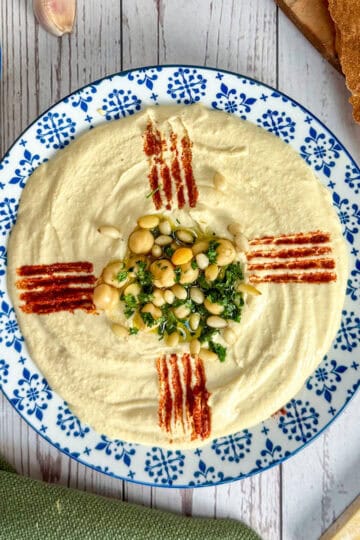
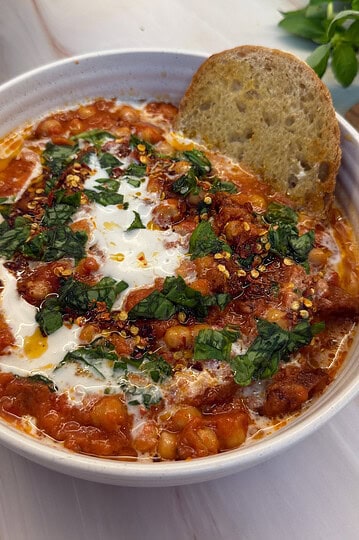
Hazem says
That is legit Koshari! Thank you for the amazing recipe and presentation